SecureCRT is a commercial project that provides users with a flexible and straightforward way of managing multiple SSH (Secure Shell) remote connections into a single, graphical and multi-platform application. It supports the SSH v1/2, Telnet, Telnet/SSL, and Serial protocols.
Even if its graphical user interface (GUI) is quite different from the powerful and popular PuTTY application, it features almost the same functionality, combining strong encryption with state-of-the-art terminal emulation.
Features at a glance
Its key features include support for configuring, managing and customizing up to 5000 connections, numerous authentication options, as well as data integrity of the Secure Shell protocol for both secure network administration and end-user access.
Besides the extremely secure remote access, the application comes with built-in support for file transfers, as well as data tunneling functionality. Simply put, it is a client for remote control, file transfer, and data tunneling using SSH.
The application allows users to transfer files between multiple network devices, supporting the SFTP (FTP over SSL), Kermit, Xmodem, Zmodem, or Ymodem protocols. In addition, it includes a TFTP (Trivial File Transfer Protocol) server.
SSH (Secure Shell) is a method to setting up a secure connection between two computers, in which both the entire network traffic is fully encrypted with the highest standards. The application is known to depend on the open standard Secure Shell protocol.
Bottom line
Summing up, SecureCRT is a quite expensive application that allows Linux, Mac and Windows users to quickly and easily establish remote SSH (Secure Shell) connections using a terminal emulator. It’s nothing more than an extended version of PuTTY that costs 99 USD (70 EUR).
On Linux, there are many other free and open source applications that can do the same thing, such as the well known GNOME’s Vinagre program or the highly acclaimed PuTTY software (both of them being graphical applications).
What is new in this release:
- Change:
- Windows: Added the ability to lock and unlock all the sessions in a tab group at once.
- Bug fixes:
- Mac: In the Session Manager and Connect dialog, it was not possible to select multiple sessions using COMMAND+< click >.
- Mac: When outputting a large file with the "cat" command to a session with column width of 256 or larger, the output was noticeably slow.
What is new in version 7.3.6:
- The New Session wizard reported an error when an IPv6 address was entered as the hostname.
- If the option "Show command window" was modified for the active session from the Session Options dialog, it did not take effect until the session was closed and re-opened.
- When first switching from tiled to tabbed sessions, the session option "Show command window" was not honored.
- If the command window was turned off while SecureCRT was in tiled mode and the application window was maximized, the sessions were not re-tiled automatically.
- When the global option "Default transfer type" was set to "Prompt for type," the option "Use this type for all files" was enabled.
- SSH2: SecureCRT hung when attempting to connect to a session that used CAPI for public-key authentication if the personal store was empty.
- Mac: SecureCRT crashed when attempting to do public-key authentication with a certificate in a format not supported by SecureCRT.
- Mac: If a password for a session was saved in the OS X keychain and then the option to save to the keychain was turned off, when connecting to the session, the authentication prompt contained an incorrect password.
- Mac: On OS X 10.11 (El Capitan), there were display issues with the San Francisco system font.
What is new in version 7.3.4:
- Bug fixes:
- If a tabbed session was closed while a transfer operation in that
- session was in progress, SecureCRT crashed.
- When SecureCRT and SecureFX were integrated, if the configuration
- passphrase was changed in one application while the other
- application was running, the sensitive data could have been
- encrypted incorrectly.
- The personal data folder could not be merged with the configuration
- folder if the personal data folder contained any empty session
- folders.
- When the Session Manager was in autohide mode and a session was
- connected, if a menu was activated using the keyboard and dismissed
- by pressing ESC, and then the keyboard accelerator to display the
- Session Manager was pressed, the Session Manager gained focus but
- remained hidden.
- SSH2: SecureCRT could crash when a smart card was used for
- authentication.
- Windows: On Windows 10, the last line of the terminal session was
- partially hidden by the bottom of the application window.
- Windows: On Windows 10, moving the SecureCRT window caused it to get
- smaller.
- Windows: On Windows 10, every time a tiled session was connected, it
- shrunk by one row and one column.
- Windows: On Windows 10, if the session rows and columns were changed
- in the Session Options dialog, the view size was one row and one
- column less than the specified values.
- Windows: PKCS11 authentication failed with FortiToken ePass2003.
- Windows: CAPI authentication failed with the Fortinet FTK300 token.
- Mac: Due to a change in OS X 10.10 (Yosemite), there can be more
- than one $PATH, which meant that the $PATH variable used by
- SecureCRT might not have contained the expected paths.
- Mac: If there were multiple SecureCRT application windows, the
- keyboard accelerators COMMAND+I and COMMAND+M did not work unless
- the Session Manager was open in all the SecureCRT windows.
- Mac: The SecureCRT version should not have been displayed in the
- title bar for official releases.
- Mac/Linux: In the Manage Agent Keys dialog, if all keys were removed
- and then the Remove button was pressed again, SecureCRT crashed.
- Mac/Linux: The Help contents, search, and glossary were not
- available.
What is new in version 7.3.3:
- New features:
- Previous versions of SecureCRT supported saving passwords and other sensitive data. In order to improve the security of this feature, SecureCRT now requires a passphrase to be created the first time version 7.3.3 runs. This passphrase will be used to encrypt and decrypt sensitive data stored in the session database, such as passwords and send/expect logon scripts.
- Bug fixes:
- SecureCRT hung if logon actions were being edited for multiple sessions and one of the strings being replaced was blank.
- The crash reporter dialog, which reports crashes for previous runs of SecureCRT, was being displayed after the SecureCRT window was displayed, which caused confusion about when the crash had occurred.
- SSH1: If the "Auto reconnect" global option was set and a session that did not have the username and/or password saved got disconnected, if the user did not respond to the username or password prompts, multiple prompts were displayed until SecureCRT eventually crashed.
What is new in version 7.3.1:
- Changes:
- In order to address the POODLE attack, SSL 3.0 is disabled by default.
- SSH2: When using public-key authentication, if the .PUB file is not present, it is created automatically so that agent will work.
- Bug fixes:
- SecureCRT could hang when attempting to stop using a personal data folder.
- Quotes were not supported in regular expressions used for keyword highlighting.
- If the global option "Exit when last session is disconnected" was set and the session option "Clear on disconnect" was set for a session and that session was connected twice, if one of the sessions was disconnected, it was not cleared.
- It was possible to activate the menu bar using a keyboard accelerator when the menu bar was disabled.
- Windows: The 32-bit version of SecureCRT could crash when the "Prompt send delay" option was set for the session and text was pasted into the session.
- Windows: The "Default.mnu" file did not include "Update Now" in the Help menu.
- Mac: SecureCRT crashed when attempting to create a Telnet session that used an SSH1 or SSH2 session as a firewall.
- Mac: X11 forwarding did not work with XQuartz on Mac OS 10.10 (Yosemite).
- Mac/Linux: After dragging a tabbed session within the application window to change its order, it was no longer possible to drag a tabbed session to a different window.
- Mac/Linux: SecureCRT did not honor the shell setting for a local shell when it was set by the "chsh" command.
- Mac/Linux: If focus was in the session manager when it was closed, it remained there.
What is new in version 7.3:
- Changes:
- Mac: The keyboard shortcut COMMAND+N opens a new window when the main application window has focus as it did in version 7.2.
- Bug fixes:
- SecureCRT crashed when attempting display the information for an incorrectly formatted SSH host key.
- Windows: Selecting the "Update Now" menu item did not reset the clock used to check for updates every 30 days.
What is new in version 7.2.6:
- The Session Manager and Connect dialog scrollable area was not large enough to show all sessions after expanding a folder that contained several sessions.
What is new in version 7.2.5:
- Changes:
- Linux: Added support for opening in a new SecureCRT window to the Ubuntu Unity QuickList icon.
- Bug fixes:
- SecureCRT could crash when TAPI sessions were closed.
- Arguments passed to logon scripts were retained and used by scripts launched from the button bar or a mapped key.
- The Connect dialog did not have a horizontal scrollbar.
- Mac/Linux: Some licenses that contained international characters were not seen as being valid.
What is new in version 7.2.4:
- Changes:
- In the Session Options dialog, the width of the Firewall dropdown was increased in order to accommodate long names.
- Bug fixes:
- When SecureCRT was installed on a machine where it had never been installed, if a session was created using the Quick Connect dialog and then the "Use dockable session manager" option was set in the Global Options dialog, the next time SecureCRT started, the Connect dialog was displayed twice.
- If a license was validated with an issue date that contained an en dash or em dash, SecureCRT crashed when the About box was displayed.
- Mac: On OS X Mavericks (10.9), under certain conditions, the scrolling speed was slow.
- Mac: On Mavericks (10.9), typing in a connected session could be slow when curses-based output was on the screen.
- Mac/Linux: Sometimes clipboard text was pasted into multiple tabbed sessions.
- Linux: If more than two sessions were connected and the Connect dialog was displayed and then dismissed, CTRL+TAB no longer switched focus between the tabbed sessions.
What is new in version 7.2.3:
- Windows: If the Quick Connect dialog was shown at startup and dismissed, clicking on the Session Manager button in the toolbar caused SecureCRT to crash.
- If the global value of "Menu Toolbar File V2" specified a templated value, such as "${VDS_INSTALL_PATH}, SecureCRT crashed on startup.
- When sessions were sorted using the option to arrange the tree logically, the sessions were not sorted correctly.
- In the Quick Connect dialog, if options such as "Show quick connect on startup" or "Save session" were changed and then the dialog was cancelled, the options were saved.
- If a new color scheme that had the same properties as an existing color scheme was created, it was not saved.
- SSH2: When the /LOCAL parameter was specified on the command line, the port forward was not established.
- SSH2: When the /REMOTE parameter was specified on the command line, the remote port forward was not established.
- Windows: For all dialogs, tooltips were added to buttons without text labels in order to provide button information for screen readers such as JAWS.
- Mac: Buttons or keys mapped to the menu functions MENU_RECEIVE_ASCII, MENU_SEND_ASCII, or MENU_SEND_BINARY did not work.
- Mac: On 10.9 (Mavericks), the text on button labels and list views was not aligned correctly.
- Mac: On 10.9 (Mavericks), disabled menu items appeared to be available instead of being grayed out.
What is new in version 7.2.2:
- Bug fixes:
- If a folder with the same name as an existing session was created in the same location as the session and the session was moved into that folder and then moved into the Sessions folder, the session was changed to a folder.
- If the session manager was unpinned and then closed, the area in the session where the session manager had been no longer scrolled.
- The command (chat) window history did not work.
- The Quick Connect dialog was not displayed at startup when the option "Show Quick Connect at startup" was set.
- Windows 8: SecureCRT crashed when attempting to upload or create a new key using the public-key assistant.
- Changes:
- Reverted the following change: The xterm keymap now sends Esc[H and Esc[F for Home and End.
What is new in version 7.2.1:
- Bug fixes:
- SecureCRT hung when a Python script tried to disconnect a session that had the "Close on disconnect" option set.
- When multiple sessions were selected in the Connect dialog or session manager using the SHIFT or CONTROL keys, sessions could incorrectly be unselected.
- Mac: If an incorrect password was saved in the keychain, it was not possible to save the correct password when using keyboard interactive authentication.
What is new in version 7.2.0:
- Changes:
- Added the ability to specify what port the TFTP server listens on.
- Bug fixes:
- SSH2: SecureCRT could crash if the SecureCRT application was closed while connecting to a session that used public-key authentication.
- Mac/Linux: If a session that started the TFTP server was connected and a local shell session was connected and disconnected and then the first session was disconnected and reconnected, the TFTP server could not be started because the port was already in use.
Limitations:
- Free 30-day evaluation copy
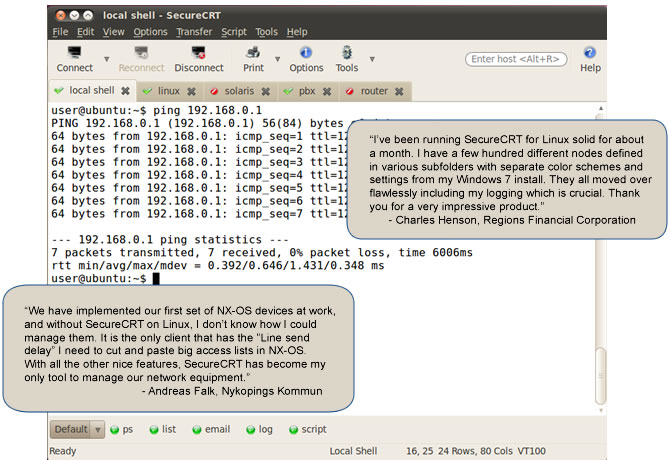
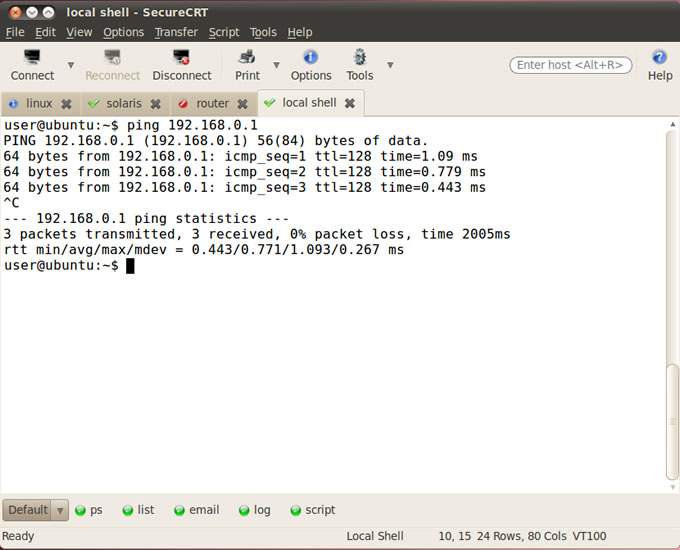
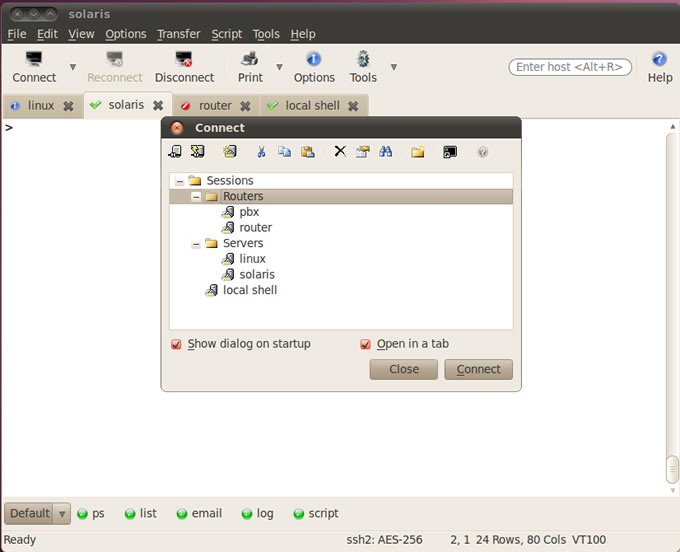
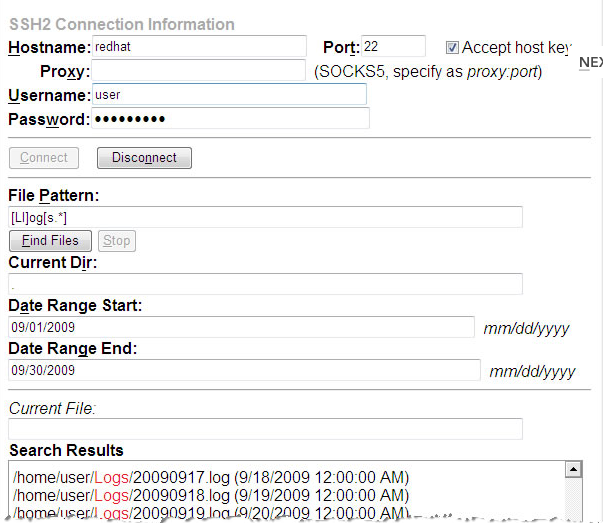

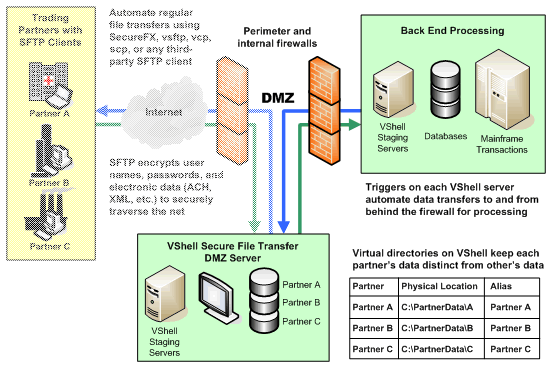
Comments not found